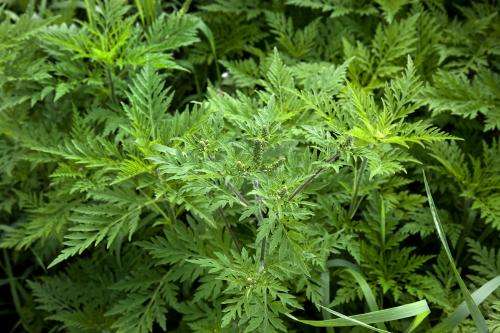Research projects contribute to shaping EU regulation to control invasive species

A new regulation governing the control of invasive alien species became effective in all EU states on 1 January 2015. The European Union hopes that it will actively combat one of the greatest threats to biodiversity and thus the functioning of ecosystems. The new regulation has far-reaching implications for authorities as well as for trade in animals and plants. The legislation also incorporates the findings of the EU's DAISIE research project and thus the findings of scientists at the Helmholtz Centre for Environmental Research (UFZ).
There are around 12,000 alien species currently in the EU and its neighbouring European countries, of which an estimated 10 to 15 percent are considered to be invasive. That means that these invasive species displace native species, impair the functioning of ecosystems or cause economic damage. Politicians are having to set priorities as there is now a very large number of invasive alien species. What is being termed a "Union List" of these prioritized species is thus to be produced by 2 January 2016 and will list species that pose transnational threats. Classification of the respective species as alien in at least three EU countries is the prerequisite for inclusion in this list. The EU DAISIE project undertook important preliminary work in this field. Between 2005 and 2008 researchers created a database, which now contains detailed information on 12,122 species and 2,440 experts on biological invasions in Europe. It also produced a list of the 100 most problematic species – including their occurrences and an assessment of the risk they pose. The EU and its member states are now faced with the challenge of deciding which of them should be included in the Union List. However, it is not intended that this will stop at pure risk assessment but rather will also include the benefits of species and regional considerations. "A species that could be a problem in Norway, for example, is not necessarily a problem in the south of Italy. It will not be easy to agree on a Europe-wide common denominator and yet still take into account regional interests when assessing the health, economic and ecological hazards," estimates the biologist Dr. Stefan Klotz of the Helmholtz Centre for Environmental Research. However, he regards the European regulation as being a major step in the right direction, as many countries are very small and, as is known, species do not stop at borders.
Consequences extending to flower beds and home aquaria
Unlike a regulation that only provides the framework and first has to be translated into national law, the new regulation has been in effect in all Member States since the start of the year. The direct legal implications will only become apparent when the Union List has been defined. "The Union List is the key element of the regulation. Once you have the list, comprehensive bans on ownership and sale will apply to the listed species. There will also be obligations on the part of the member states to enforce these bans and to take ongoing management and elimination measures where this is possible with reasonable effort and expenditure," states the environmental lawyer Prof. Wolfgang Köck of the Helmholtz Centre for Environmental Research, stressing the consequences that the legislation will have, above all, for commercial trade. There is a special transitional rule for non-commercial owners: owners of companion animals shall be allowed to keep invasive alien species included on the union list until the end of the animals' natural life, if they make sure that reproduction or escape of these animals are not possible.

The involvement of science plays a key role
"The participation of the scientific community is important to provide an adequate knowledge base to address the problems raised by invasive alien species," acknowledges the new regulation explicitly, providing for the establishment of a scientific forum to involve researchers, among other things to produce and update what is being called a "Union List" for risk assessment and emergency measures. A first meeting on this subject was held in Seville, Spain, in January. Advice from the scientific sector has already paid off: "It was originally planned to limit the list of species to be actively combated to 50," reports Professor of Biology Ingolf Kühn from the Helmholtz Centre for Environmental Research. "These plans were then dropped again after protests from the scientific sector. It simply does not make sense to impose an arbitrary number before the Member States have provided their data. Moreover, ecosystems can develop very dynamically and we therefore need to be able to respond flexibly to the latest developments in future. "
Prevention is cheaper than cure
The new legislation is not purely intended as a regulation to combat invasive species, but it also has a strong preventative character, as it is hard to combat species that have just become established or only to do so at great expense. Therefore only species, which do not yet occur in the EU or are at an early invasion stage but pose a major potential danger, should be given priority on the list. Experts therefore do not believe that the infamous giant hogweed (Heracleum mantegazzianum) or the allergy-inducing ragweed (Ambrosia artemisiifolia) will end up on the "Union List", as the cost of eliminating them would be too high. "Promising candidates" are to a greater extent the species included in an earlier nature conservation regulation and will therefore be explicitly named in the new regulation. These species include Pallas's squirrel (Callosciurus erythraeus) from Asia, the North American eastern grey squirrel (Sciurus carolinensis), fox squirrel (Sciurus niger), ruddy duck (Oxyura jamaicensis), American bullfrog (Rana catesbeiana), painted turtle (Chrysemys picta) and the red-eared slider (Trachemys scripta elegans).
Nature conservation authorities will be faced with a lot of work: within 18 months they have to determine the routes along which the reviled species are introduced into the EU, prepare action plans and establish a monitoring system. At the same time, it is hoped that this work will improve the exchange of information and establish a kind of "early warning system" so that unaffected regions can react in a timely manner.
The new EU regulation thus represents a core element of the EU strategy for the conservation of biodiversity passed in 2011. The regulation will have far-reaching implications in the coming years for authorities, retailers and even consumers, as it sets ambitious targets for solving the problems caused for nature by increasing globalisation.
More information: Regulation (EU) No 1143/2014 of the European Parliament and of the Council of 22 October 2014 on the prevention and management of the introduction and spread of invasive alien species eur-lex.europa.eu/legal-conten … uri=CELEX:32014R1143
Provided by Helmholtz Association of German Research Centres


















